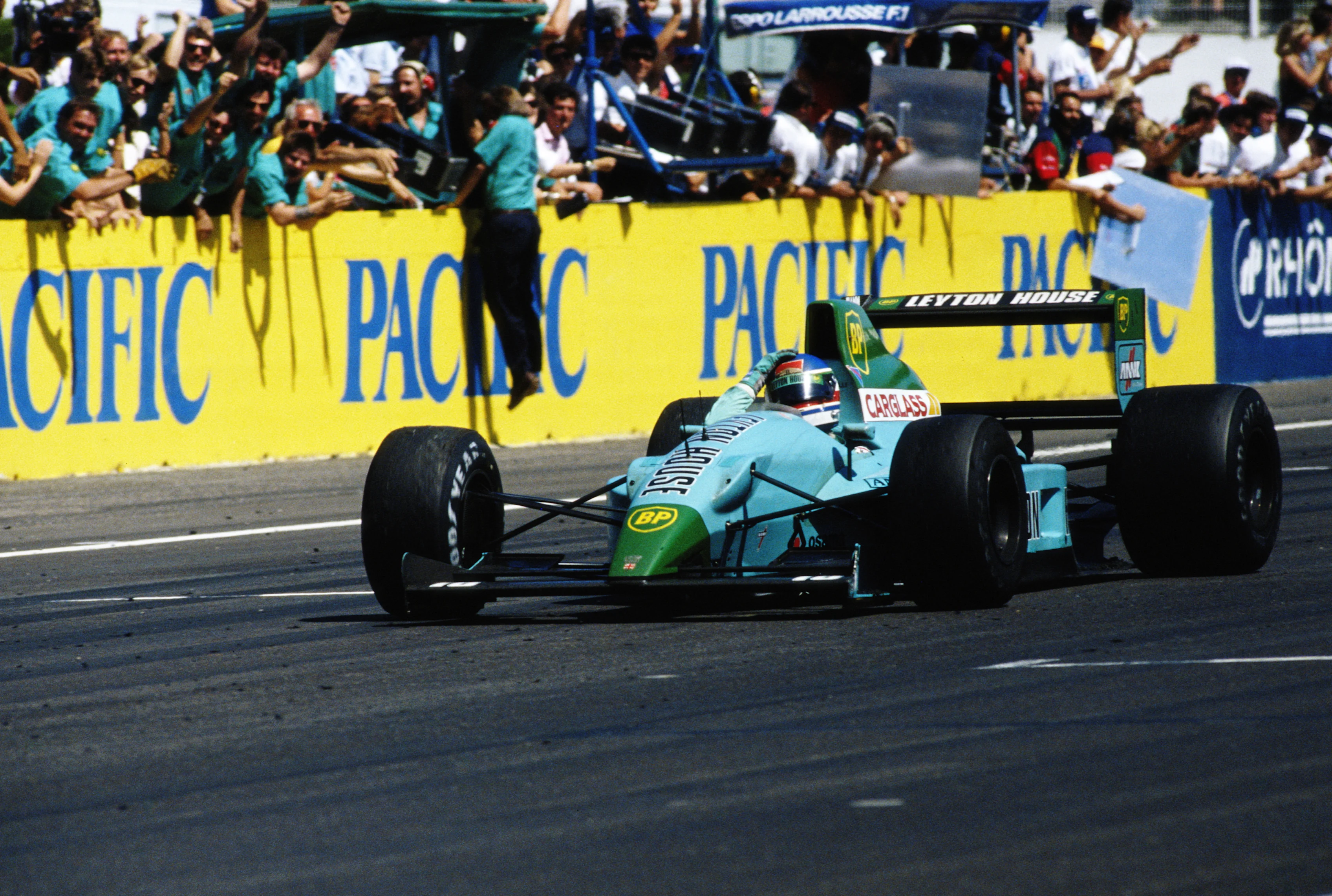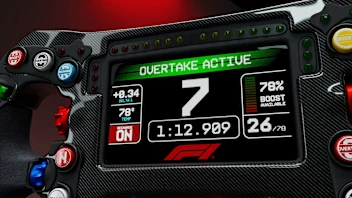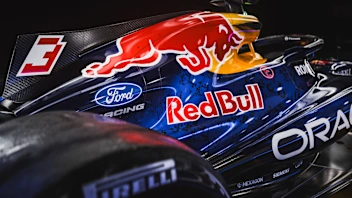These stunning cars deserved to be winners on looks alone, but poor fortune, off-track drama and many other factors meant they would never cross the finish line first. Here are 10 beautiful Formula 1 cars that looked fast, but didn't quite deliver...
1959 Aston Martin DBR4
Aston Martin’s first foray into Formula 1 was, well, forgettable.
But their entry, the DBR4, was as beautiful as the Maserati 250F (both of them low slung, front-engined Grand Prix machines) – just finished in Aston Martin’s stunning and inimitable racing green.
READ MORE: Coming back to win – Why Aston Martin's first F1 entry was one to forget
The results were anything but beautiful. Much like the Maserati 250F would have been if it was entered in 1959, the DBR4 was outdated. Its front-engine design meant it was something of a dinosaur and the likes of Cooper were far more competitive in 1959.
Here's hoping that racing green hue will return when Aston Martin unveil their 2021 challenger…
1990 Leyton House CG901
Adrian Newey's 1990 Leyton House design is widely held up as a lesson in F1 design thanks to its efficient packaging and slim form factor throughout. Oh, and it also looks flawless.
With Ivan Capelli and Mauricio Gugelmin on board, there were flashes of brilliance that season but it began dreadfully; P10 was the team's best finish in the first five races.
READ MORE: 8 of the coolest green F1 cars of all time
By the French GP, Newey's design was fixed and paying dividends – Capelli (main image) nearly won, were it not for the Ferrari of Alain Prost. Unfortunately, Newey himself had left the team by that point.
Apart from that close call in France, the team – title sponsorship and unusual, eye-catching livery owing to Japanese property company Leyton House – never could harness the full potential of their CG901 platform, folding in 1993.
1991 Ferrari 642/643
It’s no coincidence that Alain Prost’s final season with Ferrari and his first winless season since 1980 came as he campaigned the 642 and its evolution, the 643.
The Professor’s constant complaints about the Scuderia’s 1991 offerings – publicly comparing the 643’s handling to a truck – meant he was shown the door ahead of the season-ending Australian Grand Prix.
PODCAST: Prost on his amazing career, his unique relationship with Senna and his 80s rivals
Ferrari suffered their first winless season since 1986 and finished a whopping 69.5 points behind Williams in the standings.
But there were no complaints about the cars' looks. They were, after all, a continuation of the pioneering 641 – so revered for its beauty that it is on permanent display at New York City’s MoMA.
1975 Shadow DN5
Intimidating in jet black with technicolour decals sprouting out of the air intakes, the Shadow DN5 looked fast standing still.
Just as well, because this car was notoriously unreliable, with Jean-Pierre Jarier finishing just twice that season. There were hints that the DN5 could be as fast as it suggested, with pole position in its first-ever race at Argentina, again in Brazil and – at the hands of Tom Pryce – in Britain.
READ MORE: 10 of the youngest F1 line-ups in history
Frustratingly, each time it was qualified on pole position, the DN5 failed to finish the race.
Tony Southgate’s design is timeless, but the DN5’s tough exterior was the façade for a fragile interior.
1979 Arrows A2
Another Tony Southgate design, the gold Arrows A2 never reached the heights its colour implied, with a best finish of sixth over the last eight races of 1979. A radical evolution of the slapdash A1B, the A2 was supposed to run without a wing as ground effects would produce much of the downforce.
The A2 is an otherworldly creation that proves striking from any angle, those wide slicks tightly hugging a squat, sleek and seamless piece of bodywork.
READ MORE: Which is the best looking black-and-gold car in F1 history?
Yet, Arrows’ extreme take on ground effects didn’t work as planned, with the car unstable and volatile on straights while Jochen Mass would later describe its handling as “appalling”.
The A2 was scrapped at the end of the 1979 season.
1991 Jordan 191
The Jordan 191 is regarded as one of the most beautiful Formula 1 cars of all time, and whether or not you agree with that assessment, it’s undeniable that it is a thing of beauty.
That tall, narrow rear-wing overlooks a number of stunning details from designer Gary Anderson: those side air-intakes are flared towards the back of the car to reveal a drooping rear diffuser, while the airbox is oh-so-coolly swept forward like a wave. The front nose then curves towards a unique front wing design.
READ MORE: 8 amazing facts about Schumacher’s legendary F1 debut
Naked carbon fibre adorned the car in testing form, before 7UP made a last-minute decision to sponsor the team – thus dressing the 191 in one of F1’s most famous liveries.
It was capable, but didn’t quite deliver on track, with Andrea de Cesaris twice taking the car to a best finish of P4 and Bertrand Gachot unceremoniously bowing out, mid-season, to give Michael Schumacher his F1 debut.
2015 McLaren MP4-30
The first McLaren-Honda since 1992, MP4-30 signalled a new dawn for the Woking team – in a stunning metallic grey and red livery that echoed better days.
The teardrop shape implied aerodynamic mastery and Eric Boullier remarked that the elegant packaging of the Honda engine was “amazing”.
Racing royalty Fernando Alonso and Jenson Button could only watch as Mercedes ascended the throne for a second title, and McLaren finished ninth in the championship – only ahead of the beleaguered Manor-Marussia squad. That chrome livery was canned after four races, with Ron Dennis preferring black.
From 2017, McLaren decided that the future was bright; the future was orange.
2000 Jaguar R1
There’s something about green Formula 1 cars, and Jaguar’s R1 was their first in a line of contenders that were easy on the eye – but easy to overtake.
Formerly Stewart Grand Prix, Jaguar embraced Racing Green rather than tartan and white, with a metallic sheen making the car glow resplendently in the sun. The big cat roared above on the engine cover, not a single logo out of place on this exquisite piece of design.
The cat's roar was more of a meow, however, as Jaguar finished ninth that year with Eddie Irvine’s P4 at Monaco the highlight of their dire debut season.
1989 Lotus 101
Resplendent in yellow in an iconic livery, the Lotus 101 is best remembered for its looks.
It was almost a barebones offering; a simple study of how beautiful F1 cars would prove to be in the coming decade – and a tribute to the angular, aggressive machines of the ‘70s and ‘60s. The overhanging rear wing gave way to an engine cover with the slightest of bulges implying the might of the V8 underneath, imposing endplates bookending the front wing.
READ MORE: Standing out from the crowd - Yellow F1 cars though the ages
Unfortunately, Mike Coughlan and Frank Dernie's design was uncompetitive, the Judd V8 even more so. Nelson Piquet missed the podium but took a few P4 finishes, while Satoru Nakajima failed to qualify for three Grands Prix in 1989. Lotus finished sixth in a tough season.
1967 Cooper T86
Cooper were constructors who ripped up the rulebook, sparking a rear-engined revolution in 1958 – but by 1967 they were no longer the same force.
Derrick White’s Cooper T86 was menacing, with exposed tailpipes emanating from its screaming V12 Maserati, a monstrous scoop at the front and massive wheels from which its chassis hung low, like a venomous beast. The space-age-alloyed monocoque immediately proved to be lighter and faster than the T81's.
READ MORE: Argentina '58 – Moss bluffs his way to victory and ushers in new era
Yet all blame for this car's poor reliability and pace went to the ageing Maserati tipo. Jochen Rindt was reportedly so fed up with the lumbering engine that he deliberately over-revved it at the United States Grand Prix, just to blow it up. The story goes that team manager Roy Salvadori overheard his guilty admission and immediately showed Rindt the door.
That season signalled the beginning of the end for one of F1’s most storied teams. While the T86 looked the part, it couldn’t live up to its predecessors.
Next Up





.webp)
/SI202601151062%20(1).webp)
/16x9%20single%20image%20(17).webp)